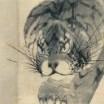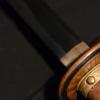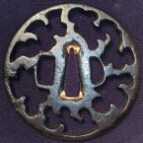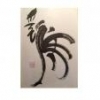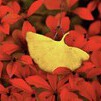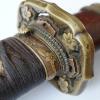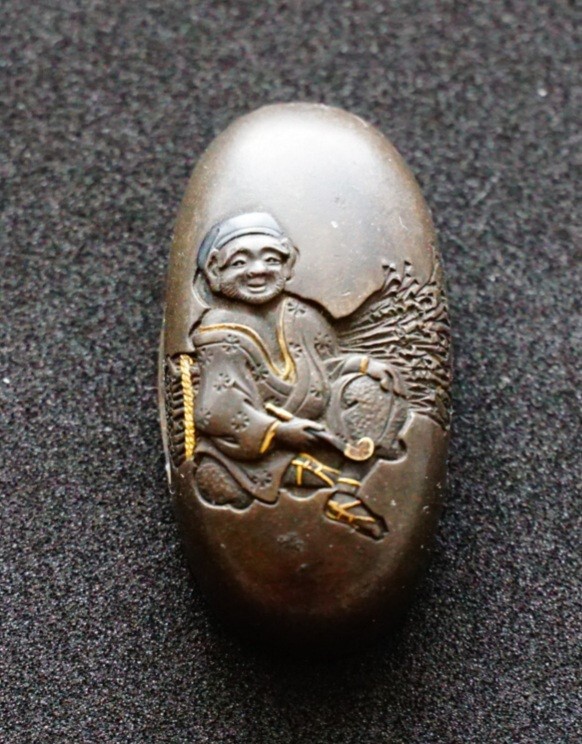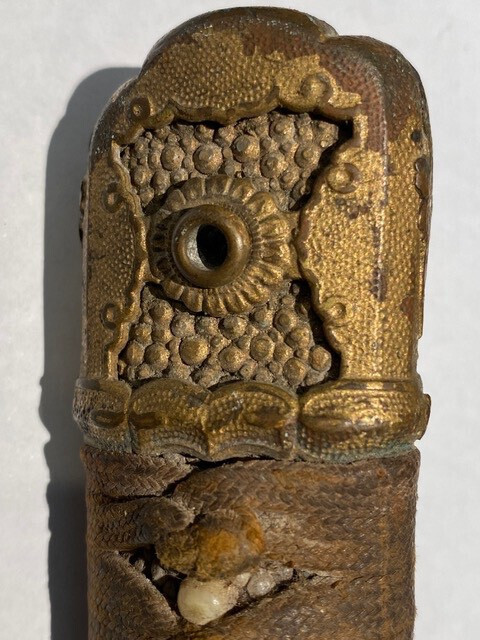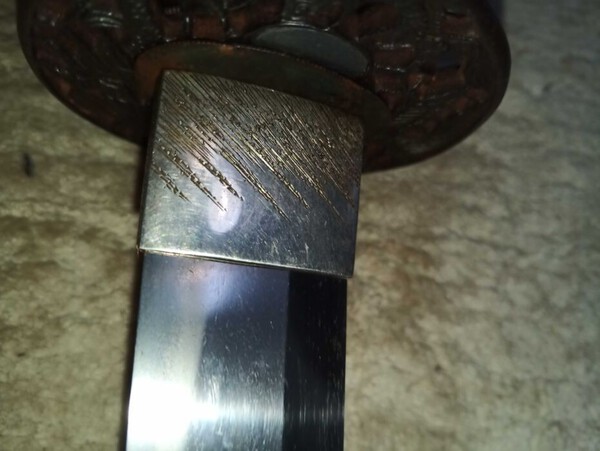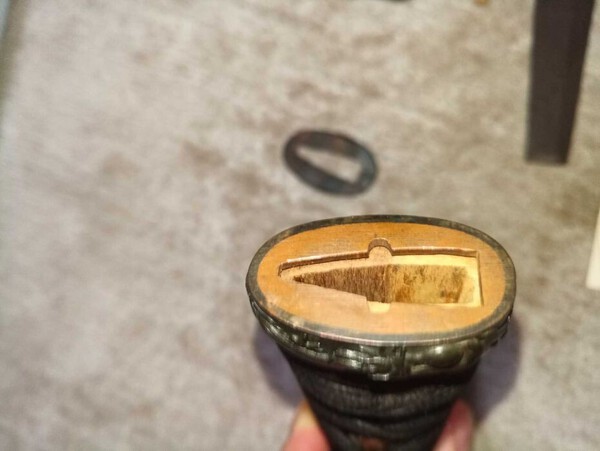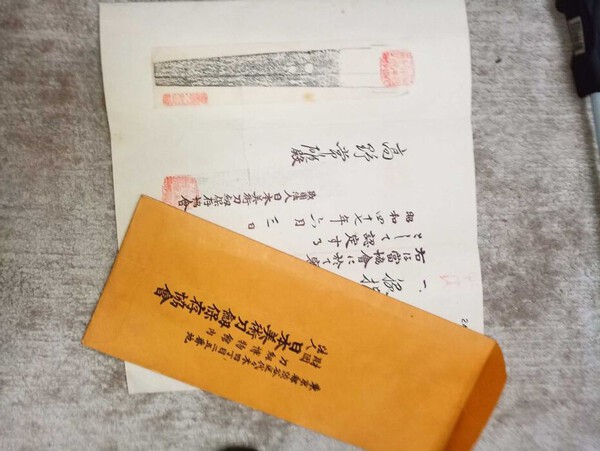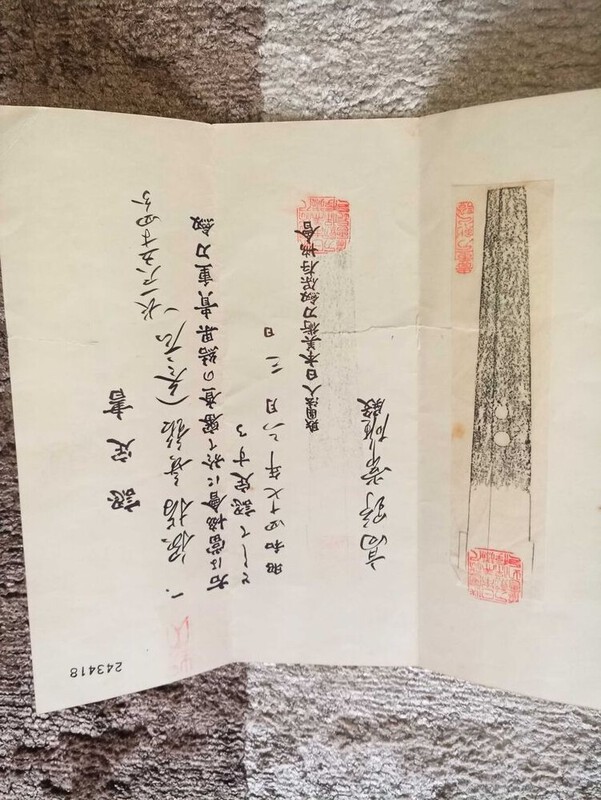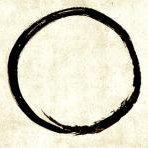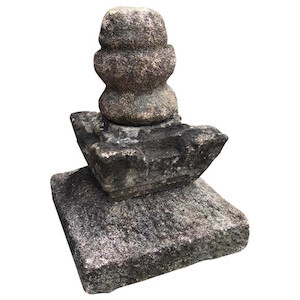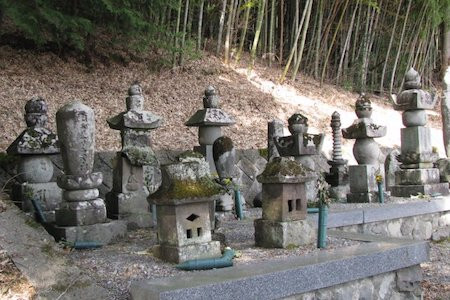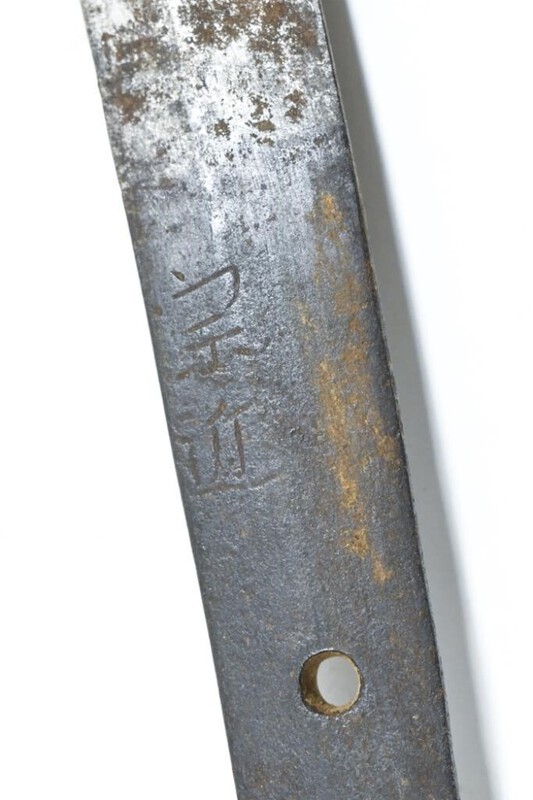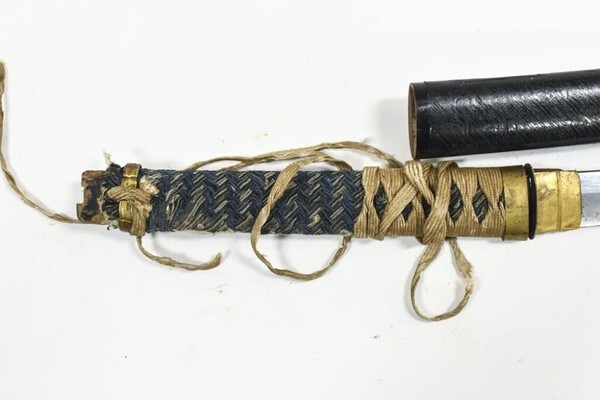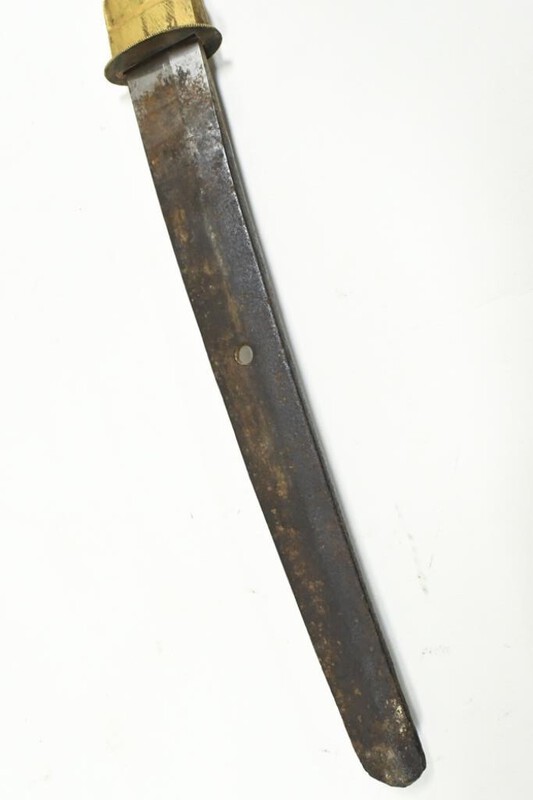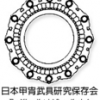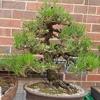Leaderboard
Popular Content
Showing content with the highest reputation on 01/03/2022 in all areas
-
Many of these new acqusitions shown above are really beautiful and valuable, and I am grateful to be allowed to study them. I am really impressed by their design and quality, so I hesitated a bit to show one of mine as it is (only) a TEIMEI TSUBA. These are not in very high regard, but to me, they have a very solid and reliable charisma, comparable to ONO and some HOAN (which are most desirable but difficult to get at). TEIMEI may lack elegance and refinement, but I like them for their strong character.4 points
-
I was fortunate to have this guard offered to me recently, and am supremely honored to be the next in a long line of caretakers. Its heavy rim encircles a typically abstract design, which is affectionately described as "Fumei" in the 2016 KTK catalog where it makes an appearance. I was enamored with the dynamic presentation of this unknown motif and excited to see if I could discover more about it. I'm never one to leave well enough alone, but hey that's part of the fun right?? Many Kanayama tsuba feature motifs derived from various religions - the iconic temple bell, daruma dolls, gourds... Even some of the not so obvious ones can be twisted in that direction. A gunbai design has been interpreted as the ears of the Buddha/Ebisu, and another well known piece has possible ties to the concept of "Mu" (emptiness) along with some serious Enso vibes. The circles on this guard are featured in the same manner on other Kanayama works, and are usually described as Sun and Moon (see also: Mind and Body, Heaven and Earth). The forms making up the hitsu ana are especially peculiar, the KTK write up notes them as possibly a "matsu pine bark kamon" or simply a "pleasant geometric abstraction" in addition to the fumei call. Whether I'm on to something or have just been starting at it for too long, I'd like to humbly suggest that they could be a depiction of a seated Buddha, and perhaps more specifically, him as an ascetic. The statue below is of this form, located at the Kita-in shrine in Saitama. If you squint just a little bit, there's a pretty striking resemblance - legs crossed, a prominent halo and the angular section emphasizing his emaciated state. While not necessarily to the Buddha's extreme (the ascetic lifestyle was abandoned in favor of the "Middle Way"), this discipline has a strong relationship with Zen, and I imagine a Bushi relating well to these teachings. The mid Momoyama period, which I believe this to be a product of, is also the source of many other similarly influenced works from Owari province in the form of ji sukashi, Yamakichibei, Hoan, and the famous inscribed tsuba of Nobuie. To those few that are still with me, it sounds crazy right? Yeah maybe a little 😅. But with the similar silhouette and circles tying into the theme, it's been a fun possibly to consider at the very least. I'd love to know if anyone has seen a design like this used on another occasion or anything juicy that might add to the speculation. I've had a blast with this piece so far and wanted to share my thoughts, and would happily open this up to any other similarly abstract guards out there that our members may have some ideas about. 👺🙏⛩️3 points
-
Vlad, The market is mature and quite efficient, so you're likely not going to make any significant profit unless you can buy for well below market value or you have a suitable client base and sales funnel to facilitate selling well above market rate. But then you'd be more a merchant than an investor. I wouldn't consider anything lesser than a Juyo candidate or work from a Mukansa smith to be an investment of any kind, and even then it would depend heavily on the purchase price. The real value of a sword won't increase, and it can't earn you a profit or pay a dividend, so it's purely speculative. There's also the issue of liquidity. If or when you want or need to liquidate, you'll likely need to sit on it for a long time before being able to sell without discounting. Finally, you likely need to sell for 20% above what you paid in order to break even after covering consignment/ auction fees and other costs. Once you've also factored in inflation, it's highly unlikely you'll be earning a profit in real terms. ------- To give some figures to illustrate the point, if you bought a sword for $10k, held it for 10 years, and inflation was 5% per year... $10k x 1.05^10 = $16.3k If we then add 20% to cover consignment/ auction fees and other costs... $16.3k x 1.2 = $19.6k. So even at a conservative 5% inflation rate, the value would need to roughly double over a ten year period for you to be standing still. That same $10k invested in an S&P 500 index fund 10 years ago would be worth $42k today and you'd have full liquidity. Taken across 30 years, that $10k put in an S&P 500 index fund in 1991 would be worth $250k today. This isn't to dissuade anyone from collecting, but rather to highlight that its maybe best thought of as a hobby. A hobby on which discretionary money is spent rather than invested. ------- My personal approach is to only buy something now if it or a direct equivalent, which I'd gladly exchange it for, won't be available in the future. This is only generally the case for high grade items or commissions. I'm quite young so I figure I can pick things up in the future for a lower price in real terms. There are a select few specific items (most of which are tsuba) which I try to keep track of. If any of those were to go on sale I would liquidate investments and buy them immediately. These are all entirely non-fungible items where I know another quite like them doesn't exist, so to me they represent special cases and once in a lifetime opportunities. If you're young and optimistic about the future you can wait to accumulate a few decades of compound interest. There are however many members here who are on the other side of this, so the economics for those individuals are very different.3 points
-
Wak in type 98 mounts are less common than standard length Katanas, however not horrible uncommon in my experience. I have found that shorter Wak, that measure less than 60cm to be "rare". I think this has to do with the measurement regulations for acceptable lengths. I believe it is discussed in another thread, but I am not sure what one. As for the Waks in non military mounts, but still had a combat saya on them, these were used mostly by non military personal that were contracted to work for the military, and if their contract position was similar to an officer rank, they would be permitted to carry. I have found many Waks in full type 98 mounts often are fancier than their full length counterparts, however this might just be due to fewer examples of waks than full length. Here are some pictures of Waks in my collection. The general tassel is not original to the sword, I have 2 more Wak gunto, however, they are just mounts, no blades.2 points
-
2 points
-
Thanks for sharing the Teimei Jean. I personally think Teimei gets an unnecessarily bad wrap. They've got some really nice designs that you'd swear were "modernist" geometric designs that seem to have been way ahead of their time. Or, once again it simply points to the massive influence that Japan has had on Western design... I recalled a quote from Chris K's NMB thread about Teimei tsuba that has stuck with me ever since I read it: "Kishu Teimei tsuba are regarded inferior with regards to quality in comparison to Kyoto, Owari or Akasaka tsuba made in the middle of Edo times. Nevertheless I noticed that in almost every big and famous collection Kishu Teimei pieces can be found." Kishu Teimei Tsuba - the beauty or the beast? - Tosogu - Nihonto Message Board (militaria.co.za) It's as if people secretly like Teimei tsuba designs, but are too hesitant to say so Here's one that I wish I could say was one of my 2021 acquisitions, but sadly, a few other bidders had deeper pockets than me at the time...2 points
-
2 points
-
I think you are correct. The characters then are as below. 雲州住藤原冬廣 = Unshū Jū Fujiwara Fuyuhiro. 雲州 = Izumo Province2 points
-
Mal, I knew you would have the skinny on this hillbilly swordsmtih! Arthur, I found you another Hidetsugu to look at. Other than these two plus yours, I can find no more. Thanks for sharing pictures of a rather hard to find smith. WWII Guntō - My grandfather received this surrendered Japanese sword while serving in WWII.2 points
-
Arty, as Kiipu says 村井秀次作 "Murai Hidetsugu saku" family name is Murai and Hidetsugu is given name which he also signs on sword. He was born Taisho 2 (1913) October 23 and registered as a swordsmith in Seki Showa 16 (1941) March 12. He was from Minami, Bugi-gun which appears to be in northern Gifu higher country. Looks to be a basic Showato maker and not to have formally trained as a swordsmith. Not many examples but can find if search NMB.2 points
-
Try a read of Darcy’s explanation of daisho to see if that helps. https://blog.yuhindo.com/daisho-and-daishoisnt/2 points
-
Dear Vladimir. Welcome to NMB! Your sword is a genuine Japanese wakizashi and the papers seem to be genuine also, though I'm afraid I cannot easily read them. Don't worry, someone will soon.. The mounts are reasonable, with a Namban tsuba. However, you say that you are seeking to use the sword for investment purposes, with this in mind most people will tell you that an unsigned wakizashi, even with papers, is not the way to go. This is a collectable sword but given past trends it will not likely increase very much in value over the short term. Others will advise you better on this but to get some idea of current prices look at the Dealer section of the forum and see what you could get for similar amounts of money. Others will add more information soon. All the best.2 points
-
I've been hijacking @Shamsy's Type 95 Black Saya thread for too long, so I'm starting a Gold-painted gunto thread to track the gold ones. I considered labeling it "Painted Gunto" to gather all the colors, but the discussions of each can get quite lengthy, so I'll keep this one just on the gold. But for reference, Steve's thread also has several examples of officer gunto painted black as well. And we have the thread on Mottled Green paint on Type 95s. I've had examples of all 3 colors and regret stripping the 2 gold-painted 95s and the mottled-green 95. I still have one black-painted 95. But back to the gold! My interest started with the acquisition of 2 Type 95s, one totally painted gold (even the blade) and a late-war 95 painted black and gold: I believe this one might have been post war as the paint come off relatively easy using acetone, and the blade, once cleaned, had lots of scratches and marks as if used plenty prior to painting. Also, there was no original paint underneath. It had been completely stripped before re-painting with gold. The late war 95: In hindsight, I now believe this one to be a wartime personalization. The paint was hard to get off with acetone, and the original color was underneath. The following are other examples that I've filed, beginning with a primo one just posted by @Arty A on this thread HERE. The paint is old and abused from use, and is covered with patina inline with the rest of the gunto: (out of time for now. Will update and continue later)1 point
-
Dear All I am a new member to the community and not an expert in Japanese blades and certificates but willing to improve my knowledge and collection. Reading a lot mostly in the internet space, since the translated books in my country regarding the subject are scares. Received information that this community is dealing with similar issues I am looking forward to your advise. Please find attached a pictures of Japanese Wakizashi, I am planning to buy. The seller claims it is original and present the certification provided bellow, bought from Ebay, Austria made in Japan. Since the money requested are not a small amount and I am planning to buy not only as collectable item, but also with investment purposes, I am looking for answer is the wakizashi real and are the papers legitimate? What might be the real market price for the blade? Thank you for your kind understanding and looking forward to your advise1 point
-
As I usually do, I make a point of buying a Christmas present for myself as a counter to the inevitable socks / shirt / sweater (delete where appropriate) from my nearest and dearest. This year, a scan through the auctions failed to find a sword of any interest, but a teppo in an auction normally devoted to modern shotguns sparked by interest and was duly acquired. When Christmas day dawned, I found to my delight that I was now the proud owner of what appeared to be a military gun that might have some age. There is no kamon or other decoration on the octagonal barrel or stock, other than the usual flower shaped around the mekugi holes. The gun has a bore of just over 16mm, which equates to 7 momme, with a barrel length of 910mm. The barrel is signed by smith named Tanaka ....? I can find in my albeit very limited references on gun-makers a Tanaka Nobuyuki 田中信之 but mine is a different person. I can make out Tanaka jugo ..... the rest being beyond me. There are also two kanji on the adjacent flat. I append images and would appreciate any assistance. Ian Bottomley1 point
-
Darcy's article covers everything important, so there really isn't much to add. To put together two unmatched blades as a daisho pair is either a marketing effort or a personal project. It could increase the value a bit for the right buyer. I personally wouldn't bother with a daisho unless papered together or newly commissioned as a matched set. Even then, I'd feel wasteful in the resource allocation and would rather have a single higher level blade or koshirae. That is unless the blades or koshirae are each interesting in their own right, and the two works form a unique unified whole. A unified work of art where the whole set is necessary and the whole is far more than the sum of its parts. So for example, matched tosogu in the theme of sun on the katana and moon on the wakizashi, or larval stage insects on the wakizashi and adult on the katana, with the whole set created together by the same hand as a single project. Matched but not identical, brother and sister or husband and wife as opposed to twins where one is a runt. I wouldn't go with a design dominated by matching kamon, for instance, unless it was of great historical importance. I'm much more taken by the idea of paired koshirae and a maki-e kake, which is an integral part of the overall design, than by a pair of matched blades. Just my personal take after many years of considering this from time to time.1 point
-
1 point
-
Dear Dan. I would respectfully suggest that you are thinking of collecting swords from a particular smith or school, a perfectly valid collecting goal, rather than assembling a daisho. I confess that I get the same urge when I see another sword by a smith whose work I already own and admire though I do not have the means to pursue that idea in any meaningful way. It has all been said above but two swords by the same maker are not in any real sense a daisho unless specific evidence points to the fact that they were made that way. The same is true for tsuba, with some of the more commonplace designs it is relatively easy to find two very similar examples and, voila, they are a daisho. At that level the concept is meaningless, find a pair of kinko tsuba whose design might not be identical but were clearly made as a daisho pair from the start and we are talking a different ball game. If you like the work of the smith in question then buying the wakizashi will give you a basis for comparative study and a chance to start to get under the skin of the maker, who knows, perhaps that will start a collecting journey. Let us know how this turns out for you. All the best.1 point
-
That is the operative question, Geoff. No one knows. And it wasn't until recently that some of us began believing that some of this strange paint was done during the war. Obviously, none of it was factory. But I'm growing to believe that individual soldiers, officer and NCO, had personalized their gunto with a paint job - black, mottled green, white, gold, and there are some other colors coming that I'm aware of. The blacks, whites, and green seem understandable as a guy would want to reduce his detectability in the field. I believe these are in @Shamsy's collection: But I haven't come up with a reason for gold. But then, who doesn't like gold, right?!1 point
-
They turn up in "field mounts" quite a lot, that is the type 98 but with the leather covered wooden scabbard, and the origin of the infamous "Tanker sword". In the formal steel scabbard much more rarely but they are known There is a whole thread (or two) on this forum, and lots of discussion as to why! (I got this pic for my personal files from here or another forum, sorry not to credit properly).1 point
-
Jan, A Happy New Year to you and other Vikings. I now have three teppo - a Saki one covered in fancy brass ornament, the Satsuma gun and now this. Thanks to Piers I also have a primer and a powder flask. All I need now is a bullet mould and I have the complete outfit. I have shot the Sakai gun with powder and a wad only. Great fun Ian1 point
-
1 point
-
The most valuble Daisho are papered together such as this example: http://www.sanmei.com/contents/media/H1461_2__S2228_PUP_E.html So if you have confirmed swords produced as a couple and koshirae produced as a couple then you know it is a "true" Daisho. But, regardless if the koshirae matches then in general we accept any combination as a diasho. Ladder theory1 point
-
1 point
-
Very solid thoughts above. I concur with Mark that unless you have bought something substantially below market (and that is extremely unusual and rare), if you are to seek nihonto as investment, you should go for high-grade items, preferably also rare. The problem is that many people are chasing such items despite their high price and they are acquired fast. With wakizashi blades, I am afraid to say, it is very, very difficult to hope for rarity, value appreciation, etc. If genuine and signed, by definition they will be Muromachi and later blades. And one needs to be careful with the quality/desirability of some Muromachi blades (many were produced back then and quality was not always good). If Shinto and Shinshinto, then you need to factor in the maker/rarity. I personally do not buy wakizashi blades unless they were shortened early Koto pieces as I am interested in Koto. On this particular blade: - some Fuyuhiro are very pedestrian and uninteresting - some are highly rated Juyo pieces and seem quite flamboyant, in decent Soshu style - the white papers seem 'legitimate' but are old/outdated/discontinued and replaced by other, modern papers (this is a separate and involved topic) - one of the papers is a registration card (torokusho) = an internal, Japan-only licence for the sword to exist within Japan legally (normally not exported outside of Japan)1 point
-
I didn't pick up anything in 2021, and not for lack of trying. I had more time on my hands this year and spent more time seeking than usual. I've averaged only 1 acquisition every 2 years since starting in this hobby, and 2021 was one of the dry years. Edit: I thought it best to add that I'm not unhappy with this, and it's entirely my own fault as I'm very picky. Most of the pieces I'm interested in have already found their way into museums, so my acquisitions tend to be newly made utsushi at the point where I lose patience with seeking antiques.1 point
-
1 point
-
1 point
-
It depends on the smith IMHO. Having a matching (and hopefully dated) set with matching koshirae increases the value way more than them sold separately. There are a lot of people that have a different take on that But I firmly believe that. Think of sudare ba by Yoshimichi Yokoyama Sukenaga Yasutsugu nanbantetsu etc etc. John1 point
-
Good morning Mojmir, At least it is morning in my part of Australia!! Never mind the kogatana, could you please post some images of the kozuka itself, both sides. It has the "look" of an old one, possibly Ko Kinko. Better minds than mine will know, but the worn look could be the use of centuries. Happy New year to all. BaZZa.1 point
-
Maybe Unshu Ju Fujiwara Fuyuhiro. This isn't Gunto; it is a significantly earlier sword. Grey1 point
-
1 point
-
1 point
-
Dear Mojmir. There have been few responses to your post, partly because it is the holiday season and partly because there is very little that can be seen from this sword and your photographs. We can see that it is a wakizashi, genuine, in mounts. It seems to have a longer kissaki but even that is hard to see. To be able to say anything meaningful for an out of polish unsigned wakizashi is not possible. If the sword is yours and you can see anything of hamon or boshi then please do tell us, that might help. Happy New Year. All the best.1 point
-
There is a saying about Kotetsu blades for every 10 mei 11 are gimei. Kiyomaro are kinda the same boat. If shoshin you could put a relative through college.1 point
-
The nengo reads “嘉永三年二月日” (Kaei 3. year a day in the 2. month = February 1850). The mei is “源清麿” (Minamoto Kiyomaro). Renowned smith, if legit….1 point
-
Not sure what to show I've purchased about 30 tsuba this year and a couple of other items. Maybe try and show just a couple of them later As you can see very sporadic but next tear I hope to be more refined in what I buy but it's just so hard My latest sale includes tsuba I didn't think I'd sell I'd love to meet another knowledgeable collector and just try and get a more objective view of my collection About 12 of the tsuba where from the NMB 2021 to 2022 Aizu Shoami - Kaneuji Bushu - Mumei = 2off Choshu - Kiyoharu Higo - Yoshiharu Higo style - Lee Kachushi style - Mumei Mito - Mumei = 3off Myochin - Mumei = 2off Nara - Mumei = 2off Onin - Mumei Shingen - Mumei Tanaka - Mumei Tosho Edo - Mumei Umetada - Mumei = 4off Umetada - Nishijin Ju Umetada Umetada Kyoto - Tadatsugu Yamakichibei - Indistinct Yamakichibei - Yamakichibei Unknown Mumei = 6 tsuba Unknown Toshiyoshi Grev1 point
-
1 point
-
Oh, man. Such great stuff to behold. Congratulations all. I will add two tsuba. Firstly, a nidai Akasaka Tadamasa. the second from 2010 but a great comparison to Bob's Akasaka futo hiki ryo mon and kiri - Akasaka sandai with Kanzan Sato hakogaki. Best Wishes for continued health and success in 2022!1 point
-
Greetings Mojmir, Those photos are a hard read being upside down, but I was able to download it and flip it. I am reading the Kogatana as 三完包吉 Misada Kaneyoshi, not too certain on if the second character is fact 完/sada, but that's my best guess. Other than that I'm not too familiar with that name or their work. I'll defer to those with more experience for further input. -George1 point
-
Dale, you are the master of hunting for comparison examples I think either "book end" style or "kake" style would work. However, I like your "kake" suggestion more, because it seems to be the most logical reason for this style's existence1 point
-
OK, I see Grey just posted. I'd like to say "thank you" to Grey because he's the first person I bought a tsuba from, which started me on this crazy journey of borderline obsession 8- this was my first purchase: a stunning copper tanto-sized tsuba with a beautiful plum branch inlay... go big or go home right? 9- Iron Tsuba with shakudo crows and silver hazy moon motif tsuba, attributed to Nara Toshimasa (Toen Sha papers) 10- a fantastic Nanban phoenix and dragon motif with extensive, finely detailed gold highlights: 11- I know these bamboo motif inlay tsuba were commonly produced in the Edo period, but does anyone know what schools produced them? I haven't seen any yet that have a mei on them... I know the Heianjo school produced some tsuba with bamboo motifs earlier on. Regardless of who made it, or when it was made, I really like this one. It looks more like copper inlay rather than the typical brass inlay on these type of tsuba. I can also see a fine gold highlight along the central vein of some leaves. 12- And to round out the inlays.... here's a Yasuchika Munechika with phoenix and kirin motif:1 point
-
I have looked at Andy's sword and hopefully helped him out some...... My impression is: Blade appears Muromachi, it is signed katana mei not tachi mei but we could see that from the pictures. The blade looks to be medium quality, i don't see any visible fatal flaws, there are some small carbon inclusions and/or small pits or ware', some nicks (polish should take out), some coarse hada (maybe core steel), habaki was tight and i didn't want to damage it so left it as is so didn't see the machi. I think it was originally signed Fujishima_______ and the smiths name has been lost. All in all the blade is an honest Koto sword, not a treasure but not junk, just mediocre. The tsuka and saya were redone probably Meiji for export (sale to foreigners), you can see the 2 hangers were not original, they were added to the saya. The tsuba is ok, nothing special my guess is Meiji, same for fuchi kashira and menuki. The hangers have dragons (one is missing on one side) and Tigers (the tigers seem to be maybe tobacco pouch ornaments, the dragons look like they were made as part of the hanger but they must of been added as you can see the spot where the missing one was attached). Probably the sword had samurai mounts and then they were tarted up in Meiji. I gave some suggestions about how to care for the sword and preserve the koshirae as it will deteriorate if left as is or mishandled. He will probably post his thoughts.1 point
-
1 point
-
1 point
-
Thank you all for the well wishes and kind words. The funeral will be Saturday. Hasnt been a nice way to start the year. I cant beleive he is gone.0 points
-
I write this post with great sadness as on Thursday evening Tomoko's husband Kyohei was taken from us after battling covid for a number of weeks. Kyohei was one of the kindest and most honorable people I was lucky enough to meet. We practiced iai and kenjutsu together regularly and I will always see him not only as one of my dearest friends but as my brother and sensei. We also enjoyed bonsai together. Today I am getting together with Tomoko to help with funeral arrangements and I will give the best wishes and condolences on behalf of Nmb and the members who have dealt with Tomoko in regards to her excellent sword bags. I dont know if anyone has any orders placed with Tomoko at the moment but im sure she will honor any business transaction but if there is any small delay please be patient . Thank you0 points




